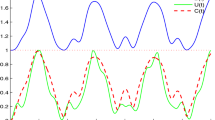Abstract
The main aim of this work is to present two different methodologies for configuration averaging in disordered systems. The Recursion method is suitable for the calculation of spatial or self-averaging, while the augmented space formalism averages over different possible configurations of the system. We have applied these techniques to a simple example and compared their results. Based on these, we have reexamined the concept of spatial ergodicity in disordered systems. The specific aspect, we have focused on, is the question “Why does an experimentalist often obtain the averaged result on a single sample?” We have found that in our example of disordered graphene, the two lead to the same result within the error limits of the two methods.




Similar content being viewed by others
References
A Cunha Physicæ (Arnold P. Gold Foundation (APGF), Brazil) 10 9 (2011)
S Chandrasekhar Radiative Transfer (New York : Dover Publications Inc.) (1960)
A Mookerjee and A Jayannavar Pramana 34 441 (1990)
M Badino The Foundational Role of Ergodic Theory (U.S.A. : Springer) 11 323 (2005)
J van Lith Study Hist. Philos. Mod. Phys. 32 581 (2001)
R Haydock Solid State Physics : Advances in Research and Applcation (New York : Academic Press) (eds.) R Haydock, H Ehrenreich, F Seitz and D Turnbull 35 p 215 (1980)
R Haydock, V Heine and M Kelly J. Phys. C : Solid State Phys. 5 2845 (1972)
R Haydock and C Nex Phys. Rev. B 74 20521 (2006)
M Luchini and C Nex J. Phys. C : Solid State Phys. 20 3125 (1987)
N Beer and D Pettifor Electronic Structure of Complex Systems (New York : Plenum Press) (eds.) P Phariseau and W Temmerman 113 p 769 (1982)
V Viswanath and G Müller The Recursion Method, Applications to Many-Body Dynamics (Germany : Springer-Verlag) H Araki, E Brezin, J Ehlers, U Frisch, K Hepp, R L Jaffe, R Kippenhahn, H A Weidenmuller, J Wess, J Zittartz and W Beiglbock (1994)
A Magnus, D G Pettifor and D Weaire The Recursion Method and its Applications (New York : Springer-Verlag) (eds.) DG Pettifor and D Weaire (1984)
A Mookerjee J. Phys. C: Solid State Phys 6 L205 (1973)
R Mills and P Ratanavararaksa Phys. Rev. B 18 5918 (1978)
S Ghosh, P Leath and M Cohen Phys. Rev. B 66 214206 (2004)
A Mookerjee Electronic Structure of Surfaces, Disordered Systems and Clusters (London & New York : Taylor & Francis) A Mookerjee and D D Sarma 4 p 168 (2003) ; (see also) T Saha Dasgupta and A Mookerjee J. Phys. Condensed Matter Phys. 6 L245 (1994)
N M R Peres, F Guinea and A H Castro Neto Phys. Rev. B 73 125411 (2006)
A Alam, B Sanyal and A Mookerjee Phys. Rev. B 86 085454 (2012)
S Chowdhury et al. Physica E 61 191 (2014)
S Chowdhury, D Jana and A Mookerjee Physica E 74 347 (2014)
V M Pereira, J M B Lopes dos Santo and A H Castro Neto Phys. Rev. B 77 115109 (2008)
P W Anderson Phys. Rev. 109 1492 (1958)
Acknowledgments
SC would like to thank DST, India for financial support through the Inspire Fellowship. This work was done under the HYDRA collaboration between our institutes.
Author information
Authors and Affiliations
Corresponding author
Appendix
Appendix
It is interesting to understand why different methods have different energy resolutions. Periodicity and the Bloch Theorem leads to the labeling of quantum states by a real vector \(\vec {k}\) and a supplementary band label ‘n’.
So that:
For a fixed \(\vec {k}\) this is a set of delta functions. If we abandon periodicity and adopt the augmented space formalism:
This spectral density comes out to be much smoother and the smoothening lifetime has its origin in scattering by disorder fluctuations. Moreover, the lifetime emerges out of the calculations, and no external broadening or smoothening factors are required.
Rights and permissions
About this article
Cite this article
Chowdhury, S., Jana, D., Sadhukhan, B. et al. Configuration and self-averaging in disordered systems. Indian J Phys 90, 649–657 (2016). https://doi.org/10.1007/s12648-015-0789-2
Received:
Accepted:
Published:
Issue Date:
DOI: https://doi.org/10.1007/s12648-015-0789-2




